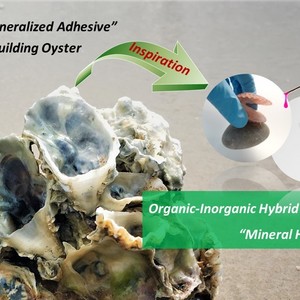Mineral-Enhanced Polyacrylic Acid Hydrogel as an Oyster-Inspired Organic–Inorganic Hybrid Adhesive
Citation
Ang Li, Yunfei Jia, Shengtong Sun*, Yisheng Xu*, Burcu Baykal Minsky, M. A. Cohen Stuart, Helmut Cölfen, Regine von Klitzing, and Xuhong Guo*. Mineral-Enhanced Polyacrylic Acid Hydrogel as an Oyster-Inspired Organic–Inorganic Hybrid Adhesive. ACS Appl. Mater. Interfaces 2018, 10, 10471-10479.
Abstract
Underwater adhesion is crucial to many marine life forms living a sedentary lifestyle. Amongst them, mussel adhesion has been mostly studied, which inspires numerous investigations of 3,4-dihydroxyphenylalanine (DOPA)-based organic adhesives. In contrast, reef-building oysters represent another important “inorganic” strategy of marine molluscs for adhesion by generating biomineralized organic–inorganic adhesives, which is still rarely studied and no synthetic analogues have ever been reported so far. Here, a novel type of oyster-inspired organic–inorganic adhesive based on a biomineralized polyelectrolyte hydrogel is reported, which consists of polyacrylic acid physically cross-linked by very small amorphous calcium carbonate nanoparticles (<3 nm). The mineral-enhanced polyelectrolyte hydrogel adhesive is shown to be injectable, reusable, and optically clear upon curing in air. Moreover, comparable adhesion performance to DOPA-based adhesives is found for the hydrogel adhesive in both dry and wet conditions, which can even be further enhanced by introducing a small amount of second large cross-linker such as negatively charged nanoparticles. The present mineral hydrogel represents a new type of bio-inspired organic–inorganic adhesive that may find a variety of potential applications in adhesive chemistry.


